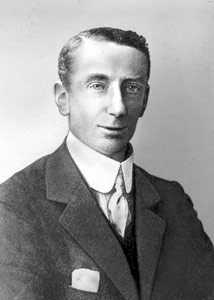Tinsley Lindley
 Tinsley Lindley | |||
| Personal information | |||
|---|---|---|---|
| Date of birth | 27 October 1865 | ||
| Place of birth | Nottingham | ||
| Date of death | 31 March 1940 | ||
| Place of death | Nottingham | ||
| Playing position | Centre Forward | ||
| Senior career* | |||
| Years | Team | Apps† | (Gls)† |
| Nottingham Forest | |||
| National team | |||
| England | 13 | (14) | |
| * Senior club appearances and goals counted for the domestic league only. † Appearances (Goals). | |||
Dr. Tinsley Lindley OBE (27 October 1865 in Nottingham – 31 March 1940 in Nottingham) was an English footballer. He was described as "an ideal centre forward". He scored three goals in his debut aged 16 for Nottingham Forest. He was an amateur who did not wear football boots but scored 14 goals for England in 13 internationals[1] Lindley was given an O.B.E. for his work during World War One and he went to practice and teach law.
Career
Lindley was the third son of Leonard Lindley who was a lace dresser and Mayor of Nottingham in 1882.[1] The family lived in Clipstone Avenue, Nottingham and Lindley attended Nottingham High School between 1875 and 1883, where he first revealed his talent.
He later attended The Leys School in Cambridge, where he turned to rugby. From 1885 to 1888 he studied at Caius College, Cambridge and during this time played football for Cambridge University,[2] and also for the Corinthians and Casuals. Tinsley obtained not just a degree but he also achieved an Master of Law and LL.D law doctorate.[2]
In 1888, he returned to his home town to join Nottingham Forest. He was the youngest ever Nottingham Forest player and at age 16 he scored three goals on his debut on 17 February 1882. In one season he scored 85 goals for Forest.[1] During the 1889-90 season also played two league matches for Nottingham rivals Notts County.
In 1891 he also played for Crusaders and Swifts for a short while before guest-playing for Preston North End in a 4-1 defeat at Sunderland in 1892.
His many transfers were due primarily to his professional full-time career and the fact that he always remained an amateur, although many clubs wanted to hire him as a professional. He was the epitome of the 'Corinthian gentleman amateur' of his time, being an academic as well as a sportsman. He refused to wear ordinary football boots when playing, preferring walking brogues instead, declaring that boots marred his great sprinting speed.[1]
International Football
His England call-up came on 13 March 1886 when, along with his Nottingham Forest team-mate Teddy Leighton, he was one of eight new caps selected to play against Ireland at Ballynafeigh Park, Belfast. Lindley scored as England "totally dominated"[3] the match with Benjamin Spilsbury scoring four goals in a 6–1 victory.[4]
It has been claimed that he holds the record for scoring in 9 consecutive England matches between 13 March 1886 and 7 April 1888. However, there is no substance whatsoever to this claim, as this includes the match against Wales on 29 March 1886, in which all contemporary reports credit the goals to George Brann, Fred Dewhurst & Andrew Amos. He did, however, score in each of the next 6 consecutive games, which is still an England record (though note that Steve Bloomer scored in 10 consecutive matches in which he played, and George Camsell in 9).[5] In total he scored 14 international goals in just 13 games. He held the overall England goalscoring record from March 1888 when he equalled Charles Bambridge's tally of 11 until his final tally of 14 was overhauled by Steve Bloomer in 1898.
First class cricket
Lindley played first-class cricket for Cambridge University and Nottinghamshire. He played ten games between 1885 and 1893 taking nearly a wicket a match as a round-arm right-armed slow to medium bowler. Lindley also averaged about 10 runs per innings as a right handed batsman.[6]
Retirement from playing
On retirement from football, Lindley turned his full attention to his law practice, having been called to the Bar in 1899 while still playing. He also lectured in law at University of Nottingham and served as a County Court Judge on the Midland Circuit. Lindley also stayed loyal to Nottingham Forest, serving on the committee for several years. During World War One, Lindley served as the Chief Officer of the Nottingham Special Constabulary and as Deputy Director of the Nottinghamshire Territorial Association. He was awarded the OBE in 1918 for these services. He lived at 14 Park Terrace in Nottingham.[2] He died in Nottingham on 31 March 1940 aged 74.[6]
In October 2013 a campaign was launched to raise £6,000 to provide a tombstone on Lindley's grave in the Wilford Hill cemetery near Nottingham. For an unknown reason, Lindley had been buried in an unmarked grave.[1] The required money was raised by Christmas 2013.[7]
References
- ↑ 1.0 1.1 1.2 1.3 1.4 "Tinsley Lindley: Campaign to mark sportsman's grave". BBC News. 30 October 2013. Retrieved 31 October 2013.
- ↑ 2.0 2.1 2.2 "Lindley, Tinsley (LNDY884T)". A Cambridge Alumni Database. University of Cambridge.
- ↑ Gibbons, Philip (2001). Association Football in Victorian England – A History of the Game from 1863 to 1900. Upfront Publishing. pp. 85–86. ISBN 1-84426-035-6.
- ↑ "Ireland 1 England 6". www.englandstats.com. 13 March 1886. Retrieved 21 November 2011.
- ↑ England's Player Record Performances at www.englandfootballonline.com
- ↑ 6.0 6.1 Tinsley Lindley, CricInfo, retrieved 22 December 2013
- ↑ "Money raised to mark Nottingham sportsman's grave". BBC. 25 December 2013. Retrieved 28 December 2013.